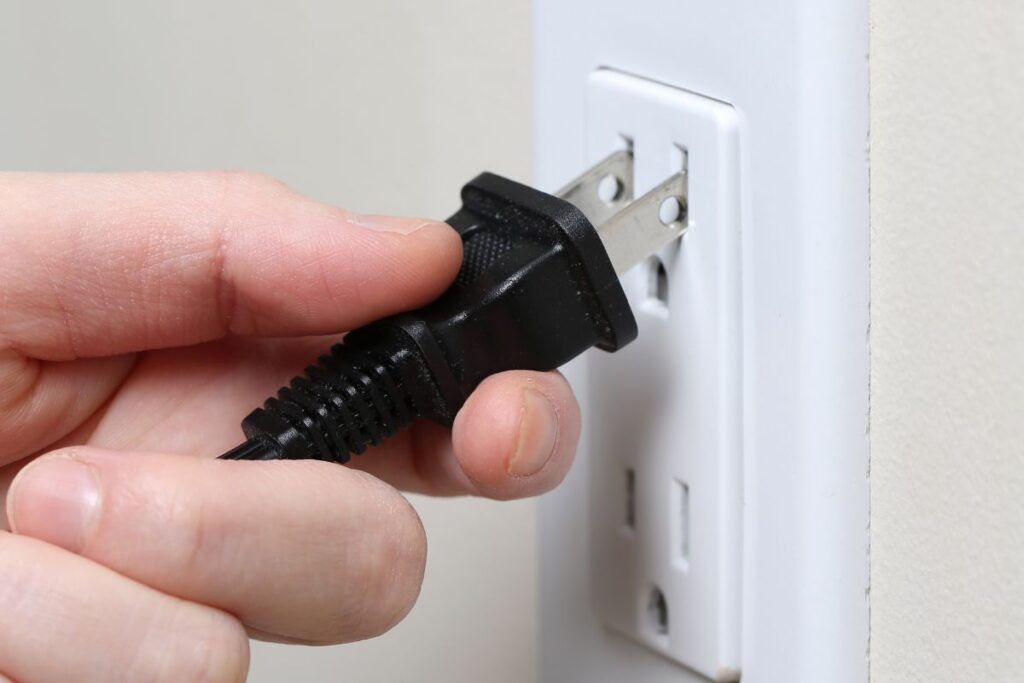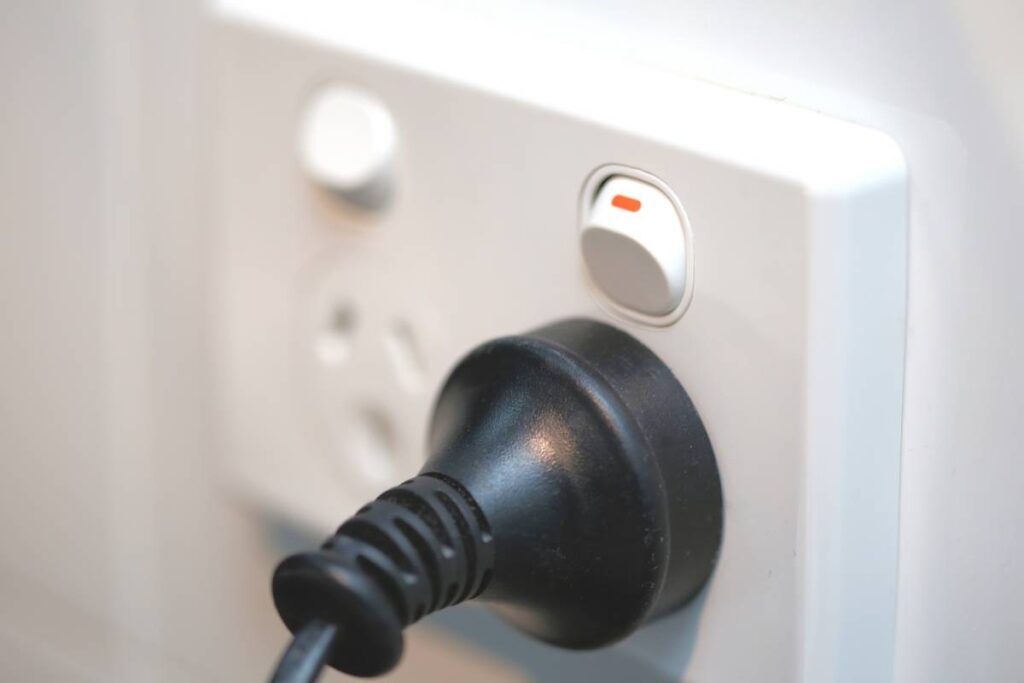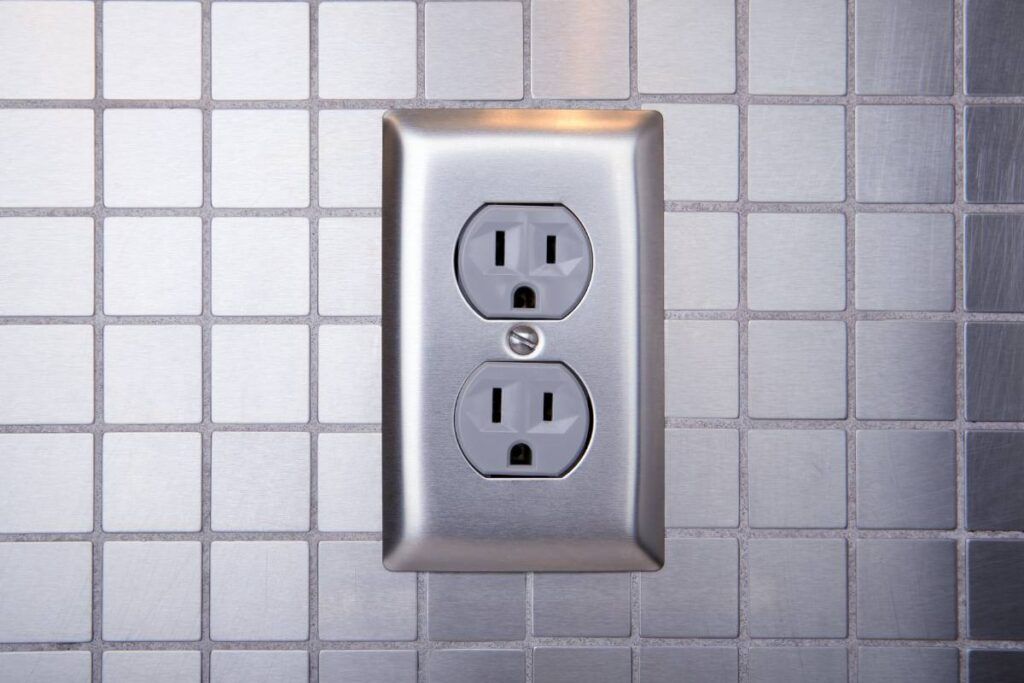It is annoying when you need to use an appliance, but the outlet gets hard to plug in the cord. Some people replace it without knowing the actual cause. You may not need to replace it if you recognize the reason. That’s what we will share today.
Common reasons could be mismatch configuration, dirt and debris, different prong size, or a broken prong in the outlet. A new or tamper-resistant outlet is hard to plug in, but it gets friendly after some time. For others, inspect one by one and solve the problem instead of just replacing it.
You should not forcibly plug in the cord if you cannot flexibly plugin. If you are curious for more knowledge, stick to the article until the end as we explore why the outlet is hard to plug in and its solutions.

Check out our list of top-handpicked products for all your electrical, appliance, and HVAC system needs to keep your home running smoothly.
This post includes some affiliate links.Why is my outlet hard to plug in?
It is common to plug in the cords to a new outlet.
News outlets are always fussy for the first few days.
When I had new outlets installed, they were always hard to plug in.
It was frustrating for the first few days.
But after some time, the outlets started working fine.
It may be hard to plug an appliance into the new outlet.
But over regular use, the outlet becomes friendly, and you can easily plug in any appliance without struggle.
But, the problem occurs when the outlet has been on regular usage, and still, you cannot plug any cord into it.
It happened with one of my outlets one day.
I was about to plug in a vacuum cleaner, but it was not getting inside the outlet.
I had dirt and debris inside the outlet, so I could not plug in the cord.
It was because I rarely used the outlet, and it was open.
However, there are several other reasons behind it.
After some research, a few common reasons are responsible for making the outlet hard to plug in.
The following sections will discuss the problems and the easy fixes for each problem.
1. Old outlet with shutters in the receptacle
Some sockets have shutters that prevent children and pets from touching the outlet receptacles and prevent electrocution.
Sometimes, these shutters can get damaged and cannot move out of the way when you need to push the prong into the outlet.
That is why pushing the plugs into the outlet seems too hard.
Easy fix:
Shutters make it difficult to plug in the cords of any appliance.
And old outlets with shutters are more challenging to deal with.
If the outlet is in good shape, you must wiggle the plug to enter the socket.
If the shutters are damaged, you must replace the outlet with a new one.
2. Incompatible or misconfigured prongs

Some plugs have two prongs, while others have three or four.
When you plug in the cord to an outlet, the outlet prongs should have the same configuration as the cord.
If the plug is a 2-prong, but the outlet has three slots, there is a mismatch in the plug configuration.
As a result, plugging the appliance cord would be difficult to plug into the outlet. You cannot force the 2-prong into a 3-slot outlet.
Another problem is the prong thickness.
If the outlet’s slots are thinner or thicker than the prong, you cannot plug the cord into the outlet.
Even if you try to plug it in, it just won’t.
Force is not an option as that can lead to several problems like a fire when the appliance runs or breakage of the outlet due to excessive force.
Easy fix:
In this problem, there is no fix except to use the correct and compatible prongs.
If you have an outlet with 2 prongs, use 2-prong plugs. For 3-slot outlets, use 3-prong plugs; for 4-slot outlets, use 4-prong plugs.
Another thing to consider is the plug’s pin size and thickness.
For example, when your outlet has 3 slots with two thin flat slots, and one round slot (used as grounding), you need a prong with two flat pins and one round pin for the grounding.
Suppose you do not have the right prong or slot in your outlet.
In that case, you can use an adapter that matches the outlet configuration and connect the cord with the adapter to run the appliances.
It can be risky, so consult your electrician before you use an adapter.
For the best results, avoid using adapters for heavy-duty appliances.
3. Obstructions in the outlet due to dirt and debris
When you fail to plug a cord into an outlet, it can be due to the dirt and debris accumulated in the outlet slots.
Children tend to push stones and other things into the slots when they play.
Playing with the outlets and pushing in such dirty things block the slot for which you cannot push the cord.
Children playing with the outlets can be dangerous as there could be chances of electrocution.
Always the children are not to be blamed.
When you use standard outlets with no shutters and don’t use them for weeks or years, dirt and debris can automatically enter the slots and block them.
I had the same problem with one of my outlets.
I installed it but did not use it.
After a few weeks, when I tried plugging my vacuum cleaner into it, it was not entering the slots.
Easy fix:
Dirt and debris create obstructions in inserting the plug into the outlet.
You need to open the outlet and remove the dirt from the slots.
You can use a screwdriver if the dirt or debris is in a position to get removed easily by the screwdriver.
Otherwise, you need to open the outlet and clean it.
My outlet was in bad shape.
So, I had to remove the cover plate and clean it.
Turn off the circuit breaker powering the outlet, unscrew the cover plate, and check for dirt and debris.
Use a soft wire brush to remove all the dirt around the outlet and the wires.
4. Broken prong inside the outlet
Sometimes, when you plug into the outlet, the prong can break and stay inside for some reason.
The reason could be a loose or half-broken prong or a prong too tight for the outlet.
This has also happened to me besides the dirt issue.
The outlet was tight for the prong, but I somehow put it inside the outlet.
However, I struggled to take it out but couldn’t, and I broke one of the prongs inside the outlet slot.
In such a condition, you cannot put any other plug into the outlet if the prong has broken and stayed inside.
I had to call an electrician to remove the prong to use the outlet again.
Easy fix:
If you find out that the outlet’s slot is stuck with a broken prong inside, you must hire an electrician to get it fixed.
If you have done work like this before, turn off the circuit breaker, open the outlet, and remove the prong.
You need to take immediate action, as it can be dangerous if you do not remove the stuck prong.
If someone touches it by mistake, he/she can receive a fatal shock.
5. Bent or misaligned pins

Suppose your outlet slots are in good shape and have the correct prong configuration.
However, you still cannot plug anything into the outlet.
It could be because of the prong pins.
Maybe one of them got bent or misaligned from its place.
Putting the prong into the outlet will be very difficult in that case.
Do not try to put the plug into the outlet forcibly.
The prong is already bent. More pressure can break the prong.
Easy fix:
If the pins are bent or misaligned, fix the pin before you put it inside the outlet by force.
Hiring an electrician for this can be a bit too much, as it is just a bent or misaligned pin of your plug.
Use a bit of pressure to make the prong straight enough to insert into the outlet slot safely.
However, if you are not confident enough, take the plug to the shop, and they will fix it.
Do not ever insert bent or misaligned prongs.
You may manage to insert it, but you will break it when you try to take it out.
6. Corroded contacts
The contacts of the outlet slots are made of metal.
Over time, these metal outlet slots can corrode due the contact with air, moisture, and other pollutants.
When these metal contacts get rusted, plugging anything inside the outlet slot becomes very difficult.
This corrosion can also interfere with the electrical connection and create resistance.
As a result, the appliances may not run efficiently at their best, even if they are in good shape.
Not only do you struggle to push in the cord, but you also need to struggle to take out the plug from the outlet.
Easy fix:
If the contacts are corroded, turn off the circuit, and open the outlet.
Please find the corroded areas, and clean them with sandpaper, a soft cloth, or a brush.
Be careful while cleaning the contact points, as you will insert the plug into them.
If the corrosion worsens, replacing the outlet with a new one is better.
Corrosion mainly happens when the contact points get exposed to moisture, air, and dirt.
Buy outlets with shutters to avoid exposing them to such elements.
7. Damaged, worn-out, or loose outlets
Outlets can damage, wear out, and become loose over time with regular use.
Though outlets can last long enough, it depends on how you treat them.
The contact points of the outlet slots can bend and lose, which makes inserting the plugs challenging.
Physical damages to the outlet, like cracks and chips, create a blockage in the outlet slots and interfere with the smooth insertion of the cord.
The tension of the outlet contacts can reduce over time due to regular wear and tear and usage.
When this happens, the outlet loses the strength to hold the plug or creates difficulty plugging in the cord.
Easy fix:
If the outlet has been damaged physically and has cracks or breakage, replacing the outlet with a new one is the only fix here.
To prevent the problem, never apply force while inserting any plugs.
Instead of applying force or replacing anything, inspect the plug’s and outlet’s condition and configuration if you have difficulty plugging cords.
8. Faulty or loose wire connections
Sometimes, the internal wiring of the outlet can become loose or faulty due to some damage.
When the wire connections are not secured properly, they can become loose and wear out faster due to the outlet’s regular usage, electricity transmission, and the appliance’s vibration.
As a result, the outlet can provide a snug fit of the plugs, making them difficult to insert into the outlet.
Easy fix:
For this problem, you must again open the outlet and fix the wire connections.
Turn off the breaker powering the outlet, and open the cover plate with the screwdriver.
Keep the screws aside safely, and check the wire connections.
If the wires feel loose, disconnect and reconnect them tightly.
Gently pull them to see whether they are tightly connected.
If the wires are wrongly connected, disconnect and reconnect them securely to their respective terminals.
If the wires are damaged or frayed, call an electrician to get them replaced.
9. Fake outlets
Regardless of the brand, your plug can enter every outlet.
It is because the market has a vast range of outlets.
Along with the originals, counterfeits and fake outlets have also been invented, which are smaller than the usual outlets.
When your plug is hard to plug into the outlet despite being in good shape, expect a fake or defective outlet.
You won’t understand the problem unless you install one.
You will only understand that the conventional prong seems larger than the outlet.
Easy fix:
If you have received fake outlets, replacement is the only fix.
To prevent this, buy high-quality outlets from a trusted brand.
Also, test the plugs before you buy them.
Ask the retailer for a plug and push it into the outlet to ensure they fit perfectly.
However, you will only know whether the outlet is a fake or a counterfeit when you install it.
So, buy good-quality, original outlets with UL certification.
10. New sockets

As I already shared earlier, news outlets are stiff to use for the first few weeks.
Some are far worse than others, as they entirely reject the plug until you force it into the outlet.
The stiffness is attractive, guaranteeing a secure connection between the plug and the outlet socket.
Loose sockets can have electrocution and fire risks and contain a small gap that encourages arcing.
Easy fix:
There is no fix for this problem.
Apply a bit of pressure to push in the plug, but do not force it too much. The outlets are plastic and can break easily.
After repeated and regular use, the outlet becomes easy and friendly for the plug to plug in smoothly.
11. Tamper-resistant outlets
Tamper-resistant plugs also make it challenging to plug any cords.
They have a terrible reputation amongst the professionals as they are more tricky to work with than the standard outlets.
However, tamper-resistant outlets can protect children from playing and tampering with the outlets.
But don’t worry; they get friendly once you use them regularly.
Easy fix:
There is no exact fix for this problem.
One thing you can do is widen the outlet openings.
I am not sure about this as I have never done this.
But I am still suggesting it because I have seen one of my friends do it.
Open the tamper-resistant outlet with a screwdriver and widen the openings slightly with the same screwdriver.
It will allow the plug blades to easily enter and fit the outlet slots.
Test the outlet before reinstalling it, and check it to fit correctly.
This can be risky if you do it alone.
Avoiding the widening and choosing better tamper-resistant outlets, like Leviton from Home Depot, Legrand, or Hubble, is better.
Legrand outlets have high-impact resistant thermoplastic construction and are readily available in the Lowe’s Department.
Hubble outlets have a unique shutter feature, making them safer than other outlets.
Plugs going halfway: What to do with such outlets?
If your plug goes only halfway inside the outlet slot, you need to turn off the power and check the inside of the slots.
Examine the prong sizes and the outlet slots for broken prongs or debris, and inspect every possible cause behind it.
The above reasons will also apply in this case.
Ensure that the plug has gone halfway inside the outlet or hanging outside halfway.
If the latter is the problem, you have an old loose outlet that requires a replacement.
According to professionals, outlets can last for 15 to 20 years.
It highly depends on how you use and treat them.
They can also last for 5 to 10 years. Recall the last time you replaced the outlet.
It is time to replace the outlet if it has been long enough.
Dangers of not pushing the plug into the outlet completely
It can be dangerous to keep the plug inserted halfway into the outlet.
When the prongs do not fully enter the outlet slot, the hot prongs are exposed.
People touching the prong by mistake can receive a fatal electrical shock.
It is more dangerous if the plug connected to the outlet is of an appliance that uses excessive power to run, for example, a dryer.
There are also risks of sparks and fire.
Partially inserted plugs become riskier if you have pets and children at home.
They are mischievous and curious about all things around them.
So, you need to be careful and avoid such conditions.
If your plug goes halfway into the outlet, examine the reason and fix it immediately to avoid accidents.
Final thoughts
If you ever find any of your house outlets hard to plug in, follow this article to find out the actual reason behind it. There are several reasons: broken prongs, misconfigured prongs, damaged and old outlets, dirt and debris inside the slots, poor wire connections, corrosion, or misaligned prongs.
Inspect one by one, and troubleshoot the problem. Sometimes, it is just outlets with shutters and new outlets. Use it and plug in the cord with some force to plug in the cord.
You may also struggle with a tamper-resistant outlet, as they have complaints about the plugging in of the cords. These problems do not have any fixes. After regular use, the outlets will become easy to get plugged in.
Do I need an electrician to replace the outlet?
Replacing an outlet is difficult, especially for people who do not have any previous experience. Besides, professionals know the process better and will follow the regulations. So, better hire an electrician to replace the outlet.
How can I childproof my house outlets?
You can use outlet covers and boxes and outlets with shutters. Install them somewhere high where they can’t reach them, or put furniture in front of the outlet.
Reference: Outlets Wikipedia
